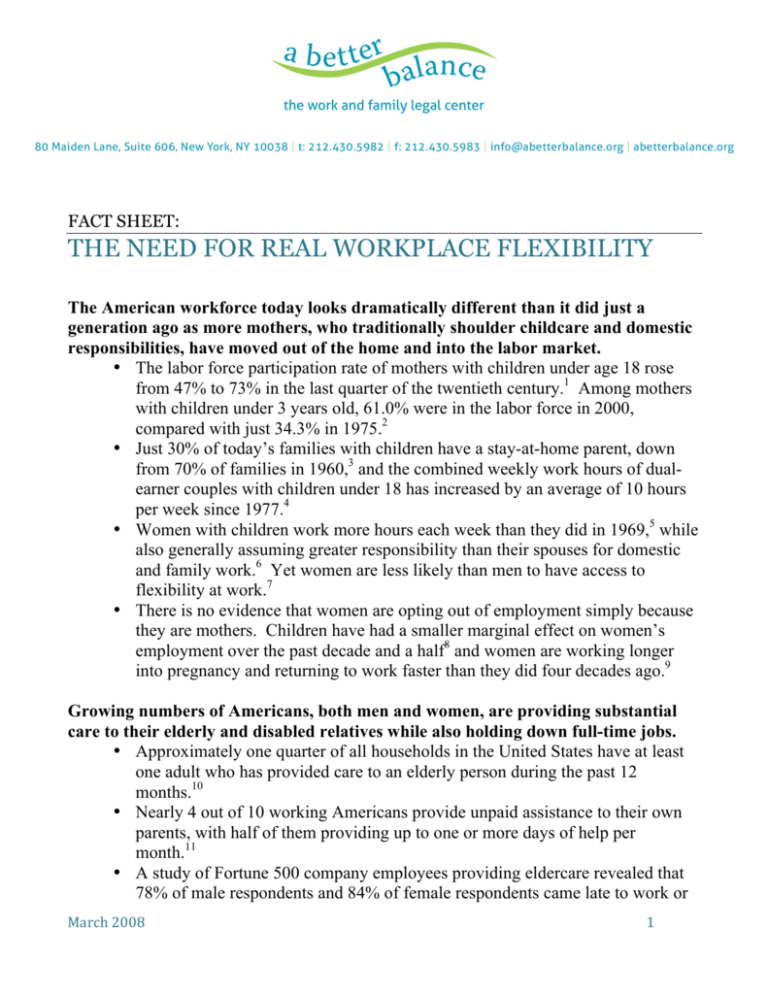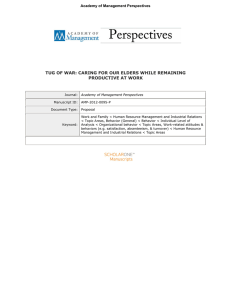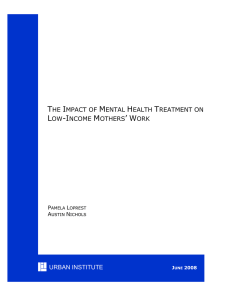Need for Workplace Flexibility
advertisement

FACT SHEET: THE NEED FOR REAL WORKPLACE FLEXIBILITY The American workforce today looks dramatically different than it did just a generation ago as more mothers, who traditionally shoulder childcare and domestic responsibilities, have moved out of the home and into the labor market. • The labor force participation rate of mothers with children under age 18 rose from 47% to 73% in the last quarter of the twentieth century.1 Among mothers with children under 3 years old, 61.0% were in the labor force in 2000, compared with just 34.3% in 1975.2 • Just 30% of today’s families with children have a stay-at-home parent, down from 70% of families in 1960,3 and the combined weekly work hours of dualearner couples with children under 18 has increased by an average of 10 hours per week since 1977.4 • Women with children work more hours each week than they did in 1969,5 while also generally assuming greater responsibility than their spouses for domestic and family work.6 Yet women are less likely than men to have access to flexibility at work.7 • There is no evidence that women are opting out of employment simply because they are mothers. Children have had a smaller marginal effect on women’s employment over the past decade and a half8 and women are working longer into pregnancy and returning to work faster than they did four decades ago.9 Growing numbers of Americans, both men and women, are providing substantial care to their elderly and disabled relatives while also holding down full-time jobs. • Approximately one quarter of all households in the United States have at least one adult who has provided care to an elderly person during the past 12 months.10 • Nearly 4 out of 10 working Americans provide unpaid assistance to their own parents, with half of them providing up to one or more days of help per month.11 • A study of Fortune 500 company employees providing eldercare revealed that 78% of male respondents and 84% of female respondents came late to work or March 2008 1 left early to accommodate their care giving responsibilities, and that over half of all respondents reported modifying their work schedules to make room for their eldercare responsibilities.12 Despite their need for some flexibility during their careers, many employees with care giving responsibilities are afraid to ask for it for fear of negative repercussions. • A study of private-sector organizations with 50 or more employees nationally revealed that 39% of employees felt somewhat or strongly that using flexible schedules and taking time off for family reasons would impede their job advancement.13 • Lower wage workers are more likely to report that using flexibility will negatively affect their advancement.14 • Many low-income, working mothers fear that their colleagues will not be understanding when they miss work (37%), and over four in ten (43%) are concerned about the effects of their care giving responsibilities on their job performance.15 Low-income workers, who often have greater work-life conflicts and fewer financial resources with which to deal with them, are most in need of workplace flexibility but also least likely to have access to it. • Low-income workers are more likely than higher-earning workers to work irregular and non-daytime shifts; 20% of employed parents in the lowest income quartile work evenings compared to 7% of those in the highest quartile.16 They also experience more mandatory, unscheduled overtime, which makes planning for childcare all the more challenging.17 • Lower- and middle-income working adults spend substantially more time than upper-income adults caring for elderly parents and in-laws.18 • Employees with incomes below $25,000 a year are much less likely to have flexibility than higher-paid workers.19 One 5-year study revealed that 78% of low-income parents found themselves in jobs with no flexibility at all.20 • Low-wage workers often suffer job action or job loss when they lack flexibility to handle routine family emergencies or predictable personal or family issues, such as doctors appointments and parent-teacher conferences, which require some time off but do not qualify for FMLA leave.21 The future promises only further demographic shifts that will ratchet up the pressure for increasing access to and improving the quality of flexible work options. • By 2020, one out of every three households is expected to be involved in caring for an elderly or disabled relative.22 March 2008 2 • There are 4 women with bachelor’s degrees for every 3 male college graduates today, but by 2017, women graduates are projected to outnumber men 3 to 2—a complete inversion from the status quo in 1957, when stay-at-home wives were the norm.23 • As women develop labor market power, economists have found that they are using it not to maximize their earnings but to secure employment that allows for more work-life balance.24 • Many of the nation’s youngest workers are expressing a distinct preference for greater work-life balance, and are unwilling to make the personal sacrifices for their careers as their parents did.25 1 U.S. Department of Labor, Bureau of Labor Statistics, “Labor Force Participation Rate of Mothers,” MLR: The Editor’s Desk, Dec. 4, 2006, available at http://www.bls.gov/opub/ted/2006/dec/wk1/art01.htm. 2 U.S Department of Labor, Bureau of Labor Statistics, “Table 7. Employment Status of Women By Presence and Age of Youngest Child, 1975-2002,” available at http://www.bls.gov/cps/wlf-tables7.pdf. 3 “Family Values at Work: It’s About Time! Why we need Minimum Standards to Ensure a FamilyFriendly Workplace,” Multi-State Working Families Consortium, 2007, pg. 5, available at http://www.9to5.org/familyvaluesatwork/FV@workSummary.pdf. 4 James T. Bond, Cynthia Thompson, Ellen Galinsky and David Prottas, “Highlights of the National Study of the Changing Workforce: Dual-Earner Couples,” Families and Work Institute, 2002, pg. 4. 5 U.S. Department of Labor, Bureau of Labor Statistics, “Hours Worked for Women with Children Rise,” MLR: The Editor’s Desk, Sept. 22, 1999, available at http://www.bls.gov/opub/ted/1999/sept/wk4/art03.htm. 6 James T. Bond, et. al., “Dual-Earner Couples,” pg. 5-6. 7 Heather Boushey, “Strengthening the Middle Class: Ensuring Equal Pay for Women,” Testimony before the House Committee on Education and Labor, April 24, 2007, pg. 4. 8 Heather Boushey, “‘Opting Out?’: The Effect of Children on Women’s Employment in the United States,” FEMINIST ECONOMICS 14(1), January 2008, 1-36. 9 Sam Roberts, “Shifts in Pregnancy and Work,” New York Times, Feb. 26, 2008. 10 “The Metlife Juggling Act Study: Balancing Caregiving with Work and the Costs Involved,” November 1999, p. 2, available at http://www.metlife.com/WPSAssets/28510693001172586490V1FJugglingStudy2007.pdf. 11 Jody Heymann, THE WIDENING GAP: WHY AMERICA’S WORKING FAMILIES ARE IN JEOPARDY—AND WHAT CAN BE DONE ABOUT IT, 103 (2000). 12 “The MetLife Study of Sons at Work Balancing Employment and Eldercare: Findings from a National Study by the National Alliance for Caregiving and The Center for Productive Aging at Towson March 2008 3 University,” Mature Market Institute, June 2003, pg. 6, available at http://geckosystems.com/downloads/sonsatwork.pdf. 13 James T. Bond, Ellen Galinsky, Stacy S. Kim, Erin Brownfield, “National Study of Employers,” Families and Work Institute, 2005, pg. 13. 14 Amy Richman, Arlene Johnson and Lisa Buxbaum, “Workplace Flexibility for Low Wage Workers,” Corporate Voices for Working Families, Oct. 2006, pg. 11. 15 Roberta Wyn and Victoria Ojeda, “Women, Work, and Family Health: A Balancing Act”, Issue Brief of The Henry J. Kaiser Family Foundation, April 2003, pg. 3, available at http://www.kff.org/womenshealth/loader.cfm?url=/commonspot/security/getfile.cfm&PageID=14293. 16 Jody Heymann, THE WIDENING GAP, 114. 17 Amy Richman, et. al., “Low Wage Workers,” pg. 10. 18 Ibid. at 115. 19 Amy Richman, et. al., “Low Wage Workers,” pg. 14. 20 Jody Heymann, THE WIDENING GAP, 133. 21 Amy Richman, et. al., “Low Wage Workers,” pg. 15. 22 M.P. McQueen, “Employers Expand Elder-Care Benefits,” Wall Street Journal Online, July 28, 2006. 23 Jonathan Rauch, “The Coming American Matriarchy,” National Journal, Jan. 11, 2008. 24 Harbour Fraser Hadder, “Girl Power: What has Changed for Women—and What Hasn’t,” Harvard Magazine, January-February 2008, pg. 42. 25 Stephanie Armour, “Generation Y: They’ve Arrived at Work with a New Attitude,” USA Today, Nov. 6, 2005, available at http://www.usatoday.com/money/workplace/2005-11-06-gen-y_x.htm. “Especially among young people, professional status is now inextricably linked to ideas of flexibility . . .” Alex Williams, “The Falling-Down Professions,” New York Times, Jan. 6, 2008. March 2008 4










